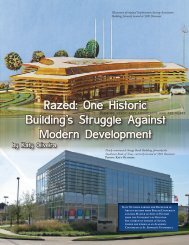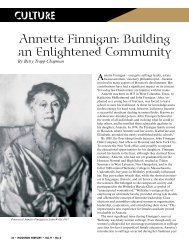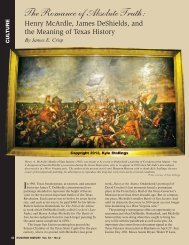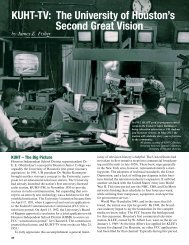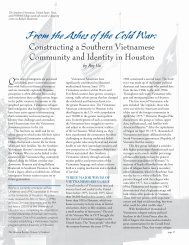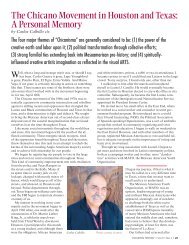Create successful ePaper yourself
Turn your PDF publications into a flip-book with our unique Google optimized e-Paper software.
of falling to the wrecking ball, as many of <strong>Houston</strong>’s buildingshave done, a joint effort of multiple entities restored thebuilding, giving it new life. While the practical and financialbenefits of saving the property made good business sense, thispreservation project carried the added importance of keeping apart of <strong>Houston</strong>’s history alive.Tracing the story of the original Humble Building throughthe 1960s and 1970s from the available sources presented achallenge. Although the structure continued to serve as an officebuilding, the records remain unclear as to when the first post-Humble/Exxon owner purchased the building. By the late 1970sand early 1980s, more and more companies relocated to businessdistricts outside of downtown, and the realty market at thecity’s center suffered. By the time a group of <strong>Houston</strong> area developersled by Sam Lutfak purchased the building from GWLRealty in 1995, ninety-five percent of the offices stood vacant.At that time, most knew it either by its address, 1212 Main, oras the “Main Building.” The same group purchased the TexacoBuilding a few months later, giving it more than one-millionsquare-feet of mostly vacant office space between the two buildings.Hoping to capitalize on a new trend toward the developmentof urban residential space, the Lutfak group began plansto turn both the 526,000 square-foot Main Building and the640,000 square-foot Texaco Building into loft apartments. 12The practice of turning office buildings into loft apartmentsreached <strong>Houston</strong> in the early 1990s when Randall Davisdeveloped the seventy-nine-unit Hogg Palace Lofts at Louisianaand Preston. Davis had seen the success of loft apartments indowntown Portland and thought the trend would work in <strong>Houston</strong>.He was right. After his early success with smaller projects,Davis pushed the loft apartment market boom to a new levelwith the conversion of the vacant Rice Hotel into a 312-unitluxury apartment building that opened in 1998. Many of theother early developments created spaces in Market Square onthe north side of downtown, but activity soon spread to centralsections of the city. Several renovations included restaurants andbars on the lower levels, and as downtown residential units increased,the city saw entertainment venues move to the area aswell. By 2000, the <strong>Houston</strong> Astros relocated to the team’s newhome at Enron Field (now Minute Maid Park) adjoining historicUnion Station. 13The new downtown development drew the attention of one ofthe nation’s biggest developers, Gerald D. Hines, who had establishedhimself in <strong>Houston</strong> before moving into other major marketsin the United States and around the world. In 1996, Hinesconsidered purchasing the old Humble Building from Lutfak’sgroup, which had focused its attention on the conversion ofthe Texaco Building, thus, making the Main Street propertyexpendable. Hines saw the potential in residential developmentand estimated that the property could yield 300 apartments, buthe questioned whether the demand would remain high enoughto turn a profit. Ultimately, Hines found renovating the HumbleBuilding too risky and chose not to purchase it. Due to Hines’decision and the Lutfak group’s attention centered on its loftyplans for the Texaco Building, the old Humble Building’s futureremained uncertain. 14Neither the Lutfak group nor Hines revealed how their plansfor the Main Street property would incorporate the building’shistoric value. Both companies saw a vacant commercial spaceconvenient for urban professionals looking to live closer to their48 Vol. 6, No. 3–Sportsworkplaces. The developers either ignored or dismissed theproperty’s historic value as the headquarters of one of the mostimportant oil companies based in Texas. In late 1997, a NewOrleans firm, Historic Restoration Inc. (HRI) expressed interestin the building and brought forth a new plan for the propertythat took historic preservation seriously.When HRI bought the Humble Building in 1998, the companyalready had experience renovating buildings in New Orleans,Detroit, St. Louis, and Baltimore. Its mission, according to thecompany’s Humble Building Project Manager, Hal Fairbanks,was “to revitalize cities through the adaptive reuse of historicbuildings.” The company thought the original building andtwo additions appeared ideal for creating a multi-use space. Itentered into the purchase agreement with a letter of intent fromMarriott’s corporate headquarters to convert the original 1921building and the 1940 addition into two hotels, and the 1936Humble Tower into loft apartments. This plan made better businesssense than turning the entire space into residential units.Downtown apartments remained in high demand and renovationscontinued on other properties, such as the former RiceHotel, but the city also needed hotel rooms to appeal to businesstravelers and tourists. HRI’s plan met both needs. Furthermore,the company announced that the conversion would followfederal historic preservation guidelines in order to qualify forfederal tax credits. 15HRI turned to the Greater <strong>Houston</strong> Preservation Alliance(GHPA) for assistance in preparing its proposals for local, state,and federal tax credits. This organization exists to raise aware-The preservation project pays tribute to the building’s heritage with an“oil derrick” fountain at the entrance to the hotel. Photo by author.



